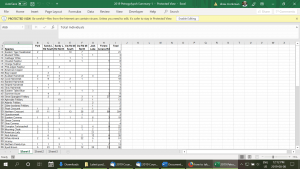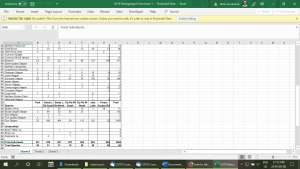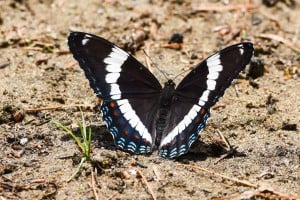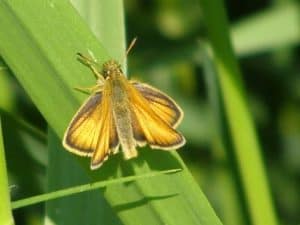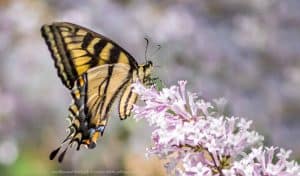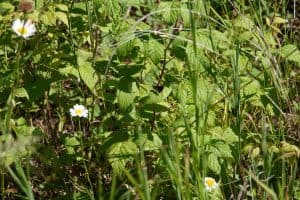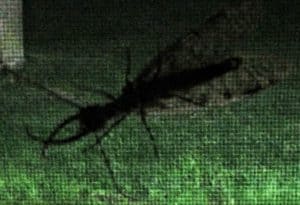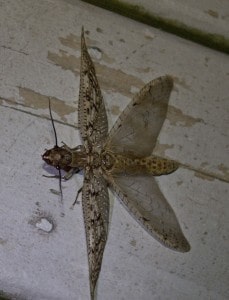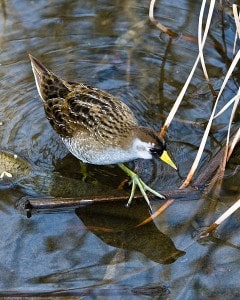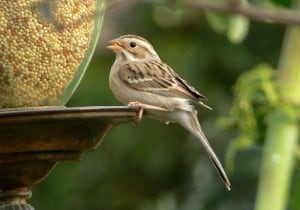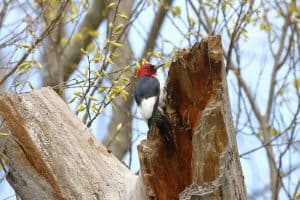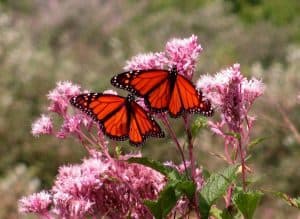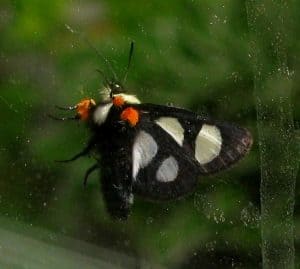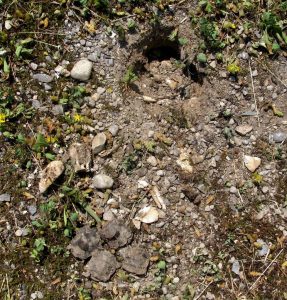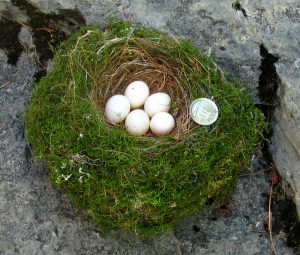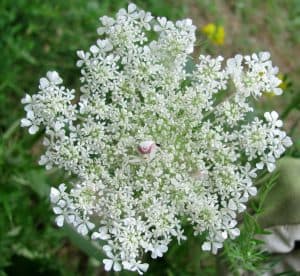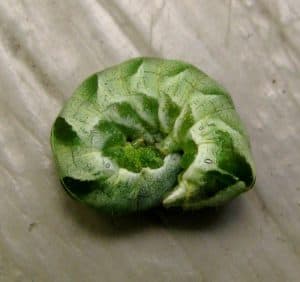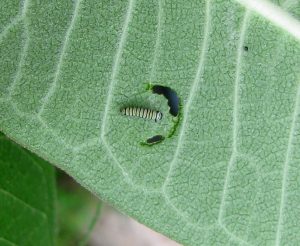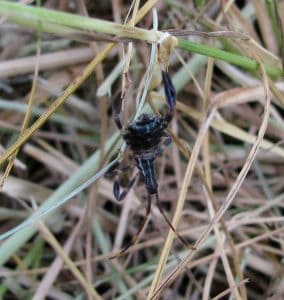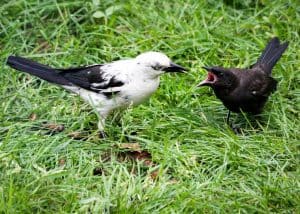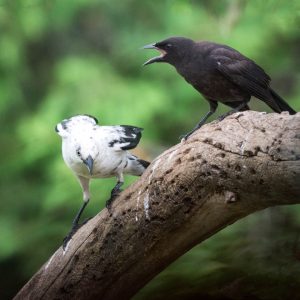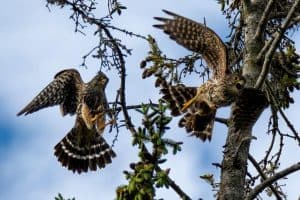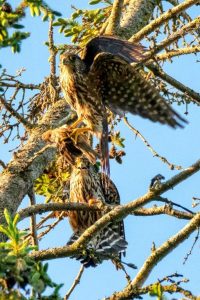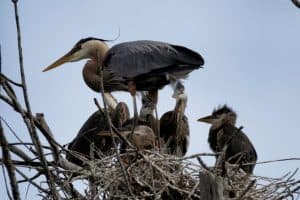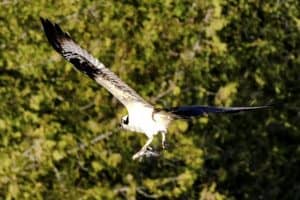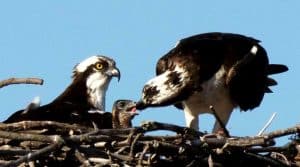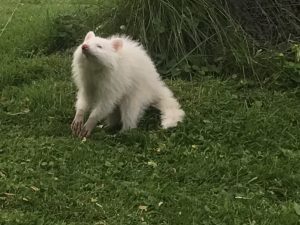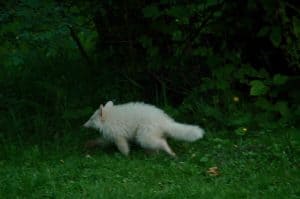20th Annual Petroglyphs Butterfly Count: The compiling of the July 21st butterfly count is finally finished and final results have been submitted to the North America Butterfly Association. A total of 55 species were recorded, slightly above the average for the last few years. The Indian Skipper found in the Park area was a new species for this count. The slow arrival of spring was a factor. The number of Monarchs (472) was very encouraging. Although the number of Dun Skippers (1,459) was well below the 4900+ seen last year, according to count compiler Jerry Ball, it will still be a continental high. The ten most common species were: Dun Skippers (1,459), Monarchs (472), Northern Crescent (304), European Skipper (286), Broad-winged Skipper (165), Eyed-brown (86), Mulberry Wing Skipper (61), White Admiral (51), Eastern Tiger Swallowtail (23), and Acadian Hairstreak (23). Martin Parker
Eastern Dobsonfly: We have never see a bug this big in our lives !! It was enormous. It was stuck to the patio screen. I gently swept it off the patio screen and it landed on the patio. The wing cover was a sliver and blended well with the patio bricks. Any clue what this “ginormous” creature is? Gord Young, Armour Road, Peterborough
Note: Your visitor was a male Eastern Dobsonfly. They average about 12 cm (5 inches) long! In the larval stage, they’re called hellgrammites and are/used to be (?) a popular bait. The larvae live in water, so I suspect this adult would have emerged from the Otonabee River. The males can’t bite, but the females, who have only tiny pincers, apparently can.
Sora (Porzana carolina) (1)
– Reported Jul 23, 2019 11:30 by Dave Milsom
– Lakefield–Sewage Lagoons, Peterborough, Ontario
– Map:
– Checklist:
Clay-colored Sparrow (Spizella pallida) (1)
– Reported Jul 22, 2019 12:35 by Kathryn Sheridan
– Lakefield Water Tower, Peterborough, Ontario
– Map:
– Checklist:
– Comments: “Continuing”
Red-headed Woodpecker (Melanerpes erythrocephalus) (2)
– Reported Jul 22, 2019 15:04 by Dan Chronowic
– Peterborough–Trent University Wildlife Sanctuary Nature Area, Peterborough, Ontario
– Map:
– Checklist:
– Comments: “Continuing. Adults. In wetland off blue trail. Seen together at top of snag.”
20th Petroglyphs Butterfly Count: This year’s butterfly count, held on July 21st, produced 55 species. The average is 51 species. The big news, however, was the 472 Monarchs we found (vs. 249 in 2018 & just 65 in 2017). With no special searching, we also found 11 Monarch larvae. Many thanks to Martin Parker & Jerry Ball for organizing the event. Drew Monkman
Sightings from the Indian River, north of Warsaw:
Today, July 25, I found a new caterpillar, a Hitched Arches Moth Caterpillar (Melanchra adjuncta) all curled up on a leaf of a flowering Common Bleeding Heart.
And while I was pruning a lilac bush I came across a tiny mystery creature about a centimeter long. Unfortunately it fell to the ground while I was trying to photograph it, but it was easier to get a picture on the rough grass. It is somewhat similar to a pseudoscorpion in both size and the presence of a pair of pincers but it also has two “tails” that pseudoscorpions do not have. Despite lengthy searches on the web, I cannot identify a name. It is a lovely shade of dark blue.
On Monday, July 22, we found three tiny Monarch caterpillars on a lone Common Milkweed that had self-seeded among a jumble of vetch, umbellifers and Bird’s-foot Trefoil near the river. And yesterday, there was another one on a Milkweed in the graveled turning circle. Here’s hoping for a ‘bumper crop’.
We also spotted a Golden-rod Crab Spider, probably a female, on the flower head of a Queen Ann’s Lace. I’ve never been a spider enthusiast, but this one was so pretty. And I’ve discovered it has one remarkable characteristic. It can change colour from yellow to white and vice versa depending on the flower it’s on, though it may take from one day to twenty to make the change. Goldenrod flowers and milkweed are common hosts.
On June 30, an Eight-spotted Forester Moth (Alypia octomaculata) alighted on one of our windows facing the river. Clean windows mean bird strikes so the image isn’t as crisp as it might be. The moth feeds on Virginia Creeper and the grape vine and is often mistaken for a butterfly because it visits flowers during the day.
About this time our neighbours were having some roof work done and an Eastern Phoebe nest was removed from a window ledge that was thought to be empty as the young had already fledged. Sadly the nest contained a second clutch of eggs. With all the handling it was decided not to put it back. The construction of the nest is a wonder to behold.
We now have three protected Painted Turtle nests. At least 2 of these nests definitely have eggs as a skunk has been trying to dig round the chicken wire. And there was a fourth nest that had been dug out with eggs shells and 4 tiny dead Painted Turtles, all rather desiccated, lying near the hole. The next day the turtles were gone, presumably eaten by the skunk. This must have been a nest from last year.
We also have one protected Snapping Turtle nest. Hopefully her nest has eggs this time but she’s fooled us before, digging an obvious second nest to distract attention from a well-covered first nest that does contain her eggs.
Lastly we spotted a mall American Toad amongst leaf litter in a wooded area. We don’t see this toad very often. Stephenie and Peter Armstrong, Warsaw
Leucistic Common Grackle: I took these photos of a leucistic Common Grackle feeding its fledgling in my backyard today, July 12. It hung around the feeder most of the day. I live on County Road 36. Sharon Watson, Lindsay.
Recent photos from Mike Faught: I took the photos of the Great Blue Heron nest in the Trent Wildlife Sanctuary. The Merlins are using the tree just off our balcony on Reid Street in Peterborough to exchange prey that they’ve caught. We see them doing this five or six times a day! Mike Faught
Albino Raccoon: Here are a couple of photos of an albino Raccoon that my neighbours, Ed Kloosterman and Valerie Anderson, shared with me. It turned up in a backyard on Engleburn Avenue near Little Lake in Peterborough in early July. Ken Brown
Western Meadowlark (Sturnella neglecta) (1)
– Reported Jul 03, 2019 09:30 by Chris Ellingwood
– Highway 36, Peterborough, Ontario
– Map:
– Checklist:
– Comments: “calling from private access lane-distinct western song, very loud and melodious whistle and warble call. Bird similar in physical appearance to eastern meadowlark in same field. Call notable.
Back off of Highway 36 on private property. May be hearable from road near Flynn’s Turn.”
